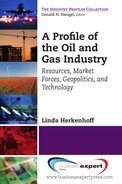Abstract
We drilled in the right place- we were simply 30 million years too late. Richard Bray President of Sohio on drilling the Mukluk Prospect, Beaufort Sea, 1983.
As early as 3000 BC, we know that the people of Mesopotamia were using crude oil as a tar for building ships and houses so, it is not by any means a new industry, but it is a volatile one. Oil and gas are important to every aspect of our economy yet this industry is distinguished by its combination of increasing demands and decreasing discovery volumes—and it is an industry shrouded in an environment of extremely volatile pricing. Although the profits enjoyed by the oil and gas industry are enormous, the industry remains one of the most capital intensive in a world where rising expenses continue to threaten to squeeze profit margins.
The Organization of Petroleum Exporting Countries (OPEC) was created in 1960 to mitigate pricing fluctuations. But this is an industry where radical action by either producers or consumers can have unpredictable consequences. This was illustrated in 1973 when the first oil crisis was triggered by political developments with the Egypt-Israel War. There followed a second oil crisis, sparked by the Iran revolution and the Iran-Iraq War. Geopolitics may continue to be the most important variable in maintaining existing assets and in successfully achieving new discoveries and carrying out their subsequent development.
But finding new oil and gas reserves is becoming more challenging, and the places where hydrocarbons are being found are more remote. Thus technology advances are also a key variable to enable exploration, drilling and development to become economically feasible in some of these more difficult operating environments.
The structure of the industry seems simple on the surface but is woven with complex relationships that are ever changing. There are only three categories of major players: international owned oil companies (IOCs), national oil companies (NOCs) that operate as corporate entities and national oil companies that operate as government agencies. Although the IOCs are among the top producers, it is important to note that 14 of the top 20 oil and gas producers are NOCs.
During the last century, oil and gas additions have exceeded demand but has this industry now reached a “peak oil” situation? Some experts argue that we are on the cusp of maximum oil production, whereas others suggest that we are still about a decade away. Others might provide arguments that identify peak oil as a moving target driven by economics and technology. Natural gas demand, however, is rising at a slightly faster rate than oil. Natural gas may be the immediate replacement fuel for oil as a source of clean and efficient electric power generation. Three out of the top ten Fortune 500 companies were oil/gas companies in 2011.
This short introduction to the oil and gas industry will focus on history, operations, major companies, outside market forces, regulation and the current challenges the industry faces. Such factors as finite natural resources, the environment, economics, geopolitics, and technology will all come into play in the narrative. The focus on oil and gas is likely to continue to grow until efficient, environmentally safe alternate fuels become available. The oil and gas industry will continue to have an enormous impact on life on our planet.
Keywords
oil, gas, energy, resources, petroleum, hydrocarbons, shale sands, reserves, seismic, fossil fuels
